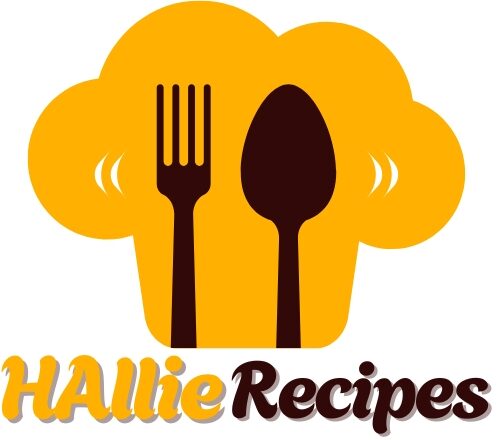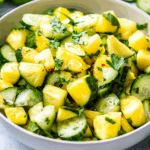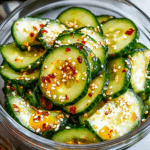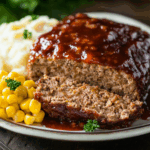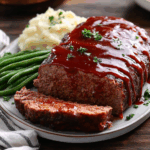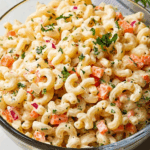This Vegan Banana Bread is a moist, flavorful loaf made without any animal products. It uses ripe bananas for natural sweetness and a tender crumb, making it a perfect plant-based treat for breakfast or dessert.
FULL RECIPE
Ingredients
- 3 ripe bananas, mashed
- 1/3 cup vegetable oil or melted coconut oil
- 3/4 cup brown sugar or coconut sugar
- 1/4 cup plant-based milk (almond, soy, oat, etc.)
- 1 teaspoon vanilla extract
- 1 1/2 cups all-purpose flour
- 1 teaspoon baking soda
- 1/2 teaspoon baking powder
- 1/4 teaspoon salt
- 1/2 teaspoon ground cinnamon (optional)
- 1/2 cup chopped walnuts or pecans (optional)
Directions
- Preheat the oven to 350°F (175°C). Grease or line a loaf pan with parchment paper.
- In a large bowl, mix mashed bananas, oil, sugar, plant-based milk, and vanilla until combined.
- In a separate bowl, whisk together flour, baking soda, baking powder, salt, and cinnamon.
- Gradually add the dry ingredients to the wet mixture, stirring just until combined. Fold in nuts if using.
- Pour the batter into the prepared loaf pan and smooth the top.
- Bake for 50-60 minutes or until a toothpick inserted into the center comes out clean.
- Let the bread cool in the pan for 10 minutes, then transfer to a wire rack to cool completely before slicing.
Nutritional Information (per slice, based on 10 slices)
- Calories: 210
- Fat: 9g
- Saturated Fat: 2g
- Carbohydrates: 30g
- Fiber: 2g
- Sugars: 15g
- Protein: 3g
The Benefits of Vegan Banana Bread
Vegan banana bread offers numerous benefits that make it an appealing choice for many people, whether they follow a plant-based lifestyle or simply want a healthier alternative to traditional baked goods. One of the biggest advantages is that it is free from animal products, which makes it suitable for vegans and those with dairy or egg allergies. This also means it typically contains less saturated fat compared to conventional banana bread recipes that rely on butter and eggs. Using ripe bananas as the main sweetening agent not only adds natural sugars but also provides essential nutrients such as potassium, vitamin C, and dietary fiber. The bananas contribute moisture, which helps create a soft and tender crumb without the need for eggs or dairy. Additionally, banana bread is a great way to reduce food waste by using overripe bananas that might otherwise be discarded.
Nutritional Considerations and Health Aspects
From a nutritional standpoint, vegan banana bread can be a relatively wholesome treat depending on the ingredients used. The combination of bananas and whole plant-based ingredients can offer vitamins, minerals, and antioxidants. Using unrefined sugars such as coconut sugar or brown sugar can slightly improve the nutritional profile by providing trace minerals like iron and zinc, although they should still be consumed in moderation. The addition of nuts, like walnuts or pecans, can boost the content of healthy fats, protein, and omega-3 fatty acids, which support heart health and brain function. Since the recipe uses plant-based milk, it may also contribute small amounts of calcium and vitamin D, especially if fortified varieties are chosen. It’s important to note that while vegan banana bread is often perceived as healthier, it is still a baked good and should be enjoyed in balance with an overall nutritious diet.
Variations and Customizations
One of the strengths of vegan banana bread is how easily it can be adapted to suit different tastes and dietary preferences. For those who want a gluten-free option, substituting the all-purpose flour with gluten-free flour blends can work well, though it may alter the texture slightly. Adding spices such as nutmeg, ginger, or cardamom can deepen the flavor profile, while mixing in extras like dairy-free chocolate chips, dried fruits, or shredded coconut offers additional texture and sweetness. Swapping out the oil for applesauce or mashed avocado can reduce fat content while keeping the bread moist. Another popular variation is incorporating seeds like chia or flax for an added nutritional boost. These variations allow the recipe to remain flexible and enjoyable for a wide audience.
Tips for Perfect Vegan Banana Bread
Achieving the ideal texture and flavor in vegan banana bread requires attention to a few key details. First, using very ripe bananas is crucial as they provide maximum sweetness and moisture. Overripe bananas with brown spots are perfect. Mixing the wet and dry ingredients just until combined helps prevent the bread from becoming dense or tough. Overmixing can develop gluten too much and negatively impact texture. Properly measuring flour is important; too much flour can dry out the bread, so spooning flour lightly into the measuring cup instead of scooping directly from the bag is recommended. Baking times may vary depending on your oven, so checking the bread a few minutes before the suggested time ensures it doesn’t overbake. Allowing the bread to cool fully before slicing improves its structure and makes it easier to cut clean slices.
Storage and Serving Suggestions
Vegan banana bread stores well and can be kept fresh for several days at room temperature when wrapped tightly in plastic wrap or stored in an airtight container. For longer storage, it freezes beautifully; wrap it in foil or plastic wrap and place it in a freezer bag. When ready to eat, simply thaw at room temperature or gently warm slices in a toaster or oven. Banana bread is incredibly versatile for serving occasions. It can be enjoyed plain or toasted with vegan butter, nut butters, or fruit spreads. Adding a drizzle of maple syrup or a dusting of powdered sugar can enhance its sweetness. It also pairs well with a hot beverage like coffee, tea, or plant-based milk. This makes it a convenient and delicious option for breakfasts, snacks, or even a light dessert.
Environmental and Ethical Impact
Choosing vegan banana bread aligns with broader goals of sustainability and ethical eating. Plant-based baking reduces reliance on animal agriculture, which is a significant contributor to greenhouse gas emissions, land use, and water consumption. By opting for plant-based ingredients, bakers help lower their environmental footprint. Additionally, vegan recipes typically avoid eggs and dairy, industries that raise concerns about animal welfare. Incorporating local and organic ingredients where possible can further enhance the environmental benefits of this simple yet meaningful choice. Supporting sustainable agriculture and mindful eating practices promotes a healthier planet and aligns with ethical values many consumers are embracing today.
Conclusion
Vegan banana bread is more than just a tasty treat; it is a versatile, nutritious, and environmentally friendly choice that suits a wide range of dietary needs and preferences. Its reliance on natural ingredients like ripe bananas and plant-based milk results in a moist, flavorful loaf without the use of animal products. The recipe’s flexibility allows for numerous adaptations to fit gluten-free diets, reduce fat, or add unique flavors and textures. With proper preparation and baking techniques, it delivers a satisfying texture and sweet taste that appeals to both vegans and non-vegans alike. Beyond nutrition and taste, vegan banana bread also reflects a commitment to sustainability and ethical consumption. Whether served as a comforting breakfast, a quick snack, or a wholesome dessert, it remains a beloved staple that contributes to a healthier lifestyle and planet.
